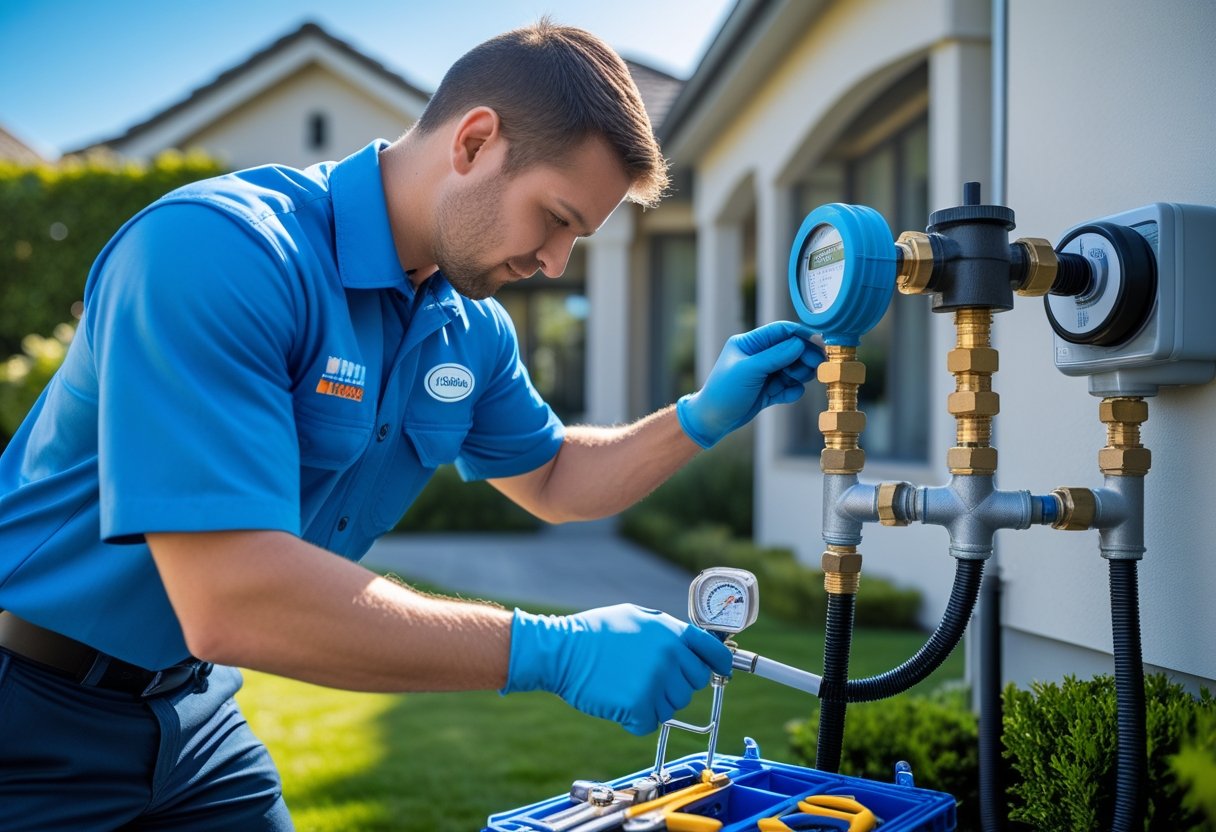If your HOA uses a backflow prevention device, you really do need to get it tested by certified professionals. Certified backflow testing protects your community’s water supply from contamination and helps you follow all the local rules. It’s such a straightforward way to avoid legal headaches and keep your neighborhood’s water safe.
Regular testing isn’t just smart—it’s usually required by law. When you work with trusted folks like Pacific Backflow, you get quick, dependable service, plus the relief of knowing all the paperwork gets filed for you. That means less stress, more time to just live your life.
Caring for backflow devices lets you spot issues early. If something needs fixing or replacing, acting fast protects your water and keeps your HOA in line with regulations. With the right help, managing your backflow system doesn’t have to be a pain.
Understanding Backflow and Its Risks
Backflow can really mess up a community water system. It’s what happens when water reverses direction, which can let dirty water mix with what should be clean. If you know what causes backflow and what’s at stake, it’s a lot easier to protect your HOA and everyone’s health.
What Is Backflow?
Backflow is when water flows backward into your clean water system. Normally, water’s supposed to move from the main supply into homes or buildings. But if the pressure drops, contaminated water can get sucked back in. That reverse flow brings in stuff you definitely don’t want—chemicals, bacteria, waste.
Backflow preventers are there to keep this from happening. They make sure water only goes one way. Certified backflow testing checks that these preventers are actually working. Skip the testing, and you can’t really trust your HOA’s water.
Common Causes of Backflow in HOAs
In an HOA, a bunch of homes and shared spaces all tie into the same water system. Several things can set off backflow here:
- Water main breaks: Sudden drops in pressure make backflow more likely.
- Irrigation systems: Sprinklers and pumps can mess with pressure, causing reverse flow.
- Firefighting: Fire hoses can pull water (and whatever’s in it) back into the system.
- Plumbing problems: Old or busted pipes sometimes let water move the wrong way.
With all that, your HOA really needs certified backflow testing to keep everyone’s water safe.
Potential Health Hazards for Communities
If backflow happens, nasty stuff can get into the water you drink. That’s a real health risk for your whole community.
Contaminants might include:
- Chemicals (fertilizers, pesticides)
- Human or animal waste
- Bacteria and viruses
These can cause all kinds of health issues, especially for kids and older folks. Preventing backflow just keeps everyone safer and the water cleaner.
Pacific Backflow handles testing and repairs so your HOA’s backflow preventers stay in shape. Keeping up with certified testing is honestly one of the best things you can do for your community’s health.
Why Certified Backflow Testing Matters for HOAs
Your HOA’s water system isn’t safe without regular, certified backflow testing. This process protects your water, helps you avoid health risks, and can save you a lot of money and headaches down the road.
Ensuring Safe Drinking Water
Backflow testing makes sure nothing gross sneaks into your clean water pipes. Even tiny leaks or a broken valve can let bad stuff mix with your drinking water. Certified testers use special gear to check every device carefully.
When you get your backflow preventers tested by pros, you keep the water safe for everyone. This helps prevent outbreaks of illness from contaminated water. Most places require annual testing, and staying on top of it means you won’t get hit with water safety violations or fines.
Protecting Residents from Contamination
If a backflow preventer fails, all sorts of contaminants—chemicals, germs, waste—can get into your water. That’s especially dangerous for kids, older adults, or anyone with a weaker immune system.
Certified testers know what to look for and can spot problems before they turn into emergencies. They check seals, springs, and valves to make sure everything’s working. Doing this on a regular basis cuts contamination risks and keeps your family and neighbors safer.
Preventing Costly Repairs
Skipping backflow testing can snowball into bigger issues: leaks, pipe damage, or water contamination. Those repairs? They’re not cheap, and they can land the HOA in legal trouble.
Annual certified testing catches problems early, so you can fix them before they get out of hand. That saves money and helps avoid water service interruptions. Go with a reliable company like Pacific Backflow, and you get fast testing and repairs that keep your community running and compliant.
Legal Requirements for HOA Backflow Prevention
You need to get your backflow preventers tested regularly by qualified professionals to protect everyone’s water. There are rules—local, state, and sometimes HOA-specific—and ignoring them can mean fines or worse.
Local and State Regulations
You’ve got to follow state and local laws that call for backflow devices to be tested at least once a year. In California, only certified testers using approved equipment can do this.
Usually, the water district sets the testing window, often between April and September. They want testing reports sent in on time to prove you’re following the rules.
Annual testing keeps dirty water out of your clean lines and protects public health.
Compliance with HOA Rules
Your HOA is on the hook for making sure backflow preventers get tested and maintained. That usually means the HOA pays for and schedules the work, especially for shared water systems.
It’s best to work with certified pros who handle both the testing and the paperwork for the authorities.
Regular testing also helps you stick to HOA guidelines and keeps things smooth with neighbors or the board.
Consequences of Non-Compliance
If you skip required testing, your HOA could get warnings, fines, or worse—legal action. That means surprise repair bills and penalties.
Not following the rules risks contaminating the water, which is a big deal for everyone’s health. It can also damage plumbing and cost a fortune to fix.
If a device fails testing, you have to get it fixed or replaced ASAP to stay in compliance and protect your water.
Pacific Backflow provides certified testing and handles the reporting, making it easier to keep your HOA safe and legal in San Diego County.
Choosing a Certified Backflow Tester
Picking a backflow tester for your HOA? Focus on certification and how you can check it. That’s the only way to know you’re hiring someone who can legally and properly protect your community’s water. Understanding what certification means, and actually checking credentials, is pretty important.
What Certification Means
Certification means a tester’s taken the training and passed the tests that state or local authorities require. That shows they know how to inspect and maintain backflow preventers the right way. Certified testers follow up-to-date rules to keep your water safe.
Most certified testers stay current with ongoing education—laws and technology change, after all. Hiring a certified pro means the job’s done right and you won’t get fined for non-compliance. Plus, your HOA’s water system stays protected.
How to Verify Credentials
Before you hire anyone, ask to see their certification. You can check it yourself by calling your local water authority or checking their website—they usually have a list of licensed testers.
Look for certifications from well-known programs, which show the tester meets local standards. Make sure the certification’s up to date, not expired. Pacific Backflow's certified technicians cover all of San Diego County and can provide proof for your records. Always keep a copy of certificates and test reports for your HOA.
Steps Involved in Professional Backflow Testing
Backflow testing is a pretty detailed process that checks your water system’s safety using specific tools and thorough checks. Expect a straightforward inspection, precise equipment, and organized paperwork to keep everything documented.
Inspection Process Overview
A certified technician starts by looking over your backflow preventer. They check for damage or wear that could let water flow backward.
Then, they use a special device to see if the preventer really blocks dirty water from getting into your clean supply. This involves checking pressure and flow to make sure things work under different conditions.
If they find any problems, they’ll point them out. That way, your system doesn’t put your community’s water at risk—which matters a lot when multiple homes share the same lines.
Necessary Equipment Used
The main tool for backflow testing is the test kit, with gauges to measure water pressure. These gauges hook right up to the preventer’s valves.
Techs also use wrenches and special fittings to reach and operate different parts. Sometimes, they need smaller tools to tweak or adjust things during the test.
All equipment needs to be calibrated and approved to meet local standards. That’s how you get accurate results and stay in compliance.
Reporting and Documentation
After the test, the technician fills out detailed forms with all the results—whether your backflow preventer passed or needs work.
You’ll get a copy of the test report, and the testing company files everything with the city or water authorities. That keeps your HOA compliant.
This paperwork keeps your records up to date and makes future inspections a lot less stressful.
Pacific Backflow handles all of this across San Diego County, keeping your HOA’s water protected with fast, reliable testing and reporting.
Maintenance Recommendations for HOAs
Keeping your backflow prevention devices in good shape is crucial for your community’s water. You’ve got to stick to a regular testing schedule and know the signs of a failing device. Both help you dodge expensive problems and keep everything safe.
Routine Testing Schedules
You should test your backflow preventer at least once a year. California law and most local authorities require it. Annual testing makes sure your device’s doing its job and keeps contamination out.
Only certified techs—like the folks at Pacific Backflow—should handle these tests. They use the right tools to check if everything’s working. Test results need to be reported to the city or water authority, too.
Some HOAs might need more frequent tests if the county says so or if there’s been recent repair work. Keeping tabs on test dates and reports helps you stay organized and avoid fines.
Signs of Backflow Device Failure
Keep an eye out for signs your backflow device might be on the fritz. You might notice leaks around the unit or odd noises when it’s running. If your water pressure drops or the water starts tasting or smelling off, that’s another red flag.
If annual testing shows the device isn’t up to par, you’ll need to repair or replace it fast. Ignoring these warning signs? That’s risky for your community’s water and could even get you fined by the water district.
Stay ahead of problems with regular checkups and quick fixes. It’s smart to use sturdy cages around your device to stop theft or tampering—unfortunately, that happens more than you’d think.
Enhancing Community Value with Certified Backflow Testing
Certified backflow testing isn’t just a box to check off—it keeps your community’s water safe and actually boosts property value. It helps avoid expensive headaches down the road and builds trust among neighbors by showing you care about everyone’s health.
Improving Property Values
When your HOA pays for certified backflow testing, it shields the entire water system from contamination. Buyers notice this stuff. A safe, well-maintained water supply means fewer health worries and less chance of big repair bills.
Communities that keep up with certified testing show they play by the rules. That makes homes more appealing and helps keep market values up. Plus, it heads off surprises that could scare buyers away or drag prices down.
Backflow testing is kind of like insurance for your water system. It keeps things running smoothly and protects your investment for the long haul.
Fostering Resident Trust
People want to feel confident their water’s safe. Certified backflow testing tells residents their HOA takes health and safety seriously. It blocks harmful stuff from sneaking into the drinking water—no one wants to mess around with that.
When pros like Pacific Backflow handle regular testing, it’s clear your community cares about water quality. That kind of effort helps trust grow between residents and management. And honestly, when folks see you’re on top of things, they complain less and feel more at home.
That sense of trust makes a difference. People want to live where their well-being is a priority. Certified testing helps your HOA become the kind of place people brag about.
Addressing Common Misconceptions about Backflow Testing
Think backflow testing is a one-and-done deal? Not quite. You’ve got to do it every year to keep your community’s water safe and stay on the right side of local laws. Skip it, and you could end up with some nasty surprises in your water system.
A lot of people assume anyone can handle backflow testing, but only certified professionals can do it and give you the reports you need. Those reports prove you’re following the rules and help you dodge penalties.
Worried backflow testing is a hassle or costs a fortune? Most HOAs find it’s easier than expected. Certified testers take care of the paperwork and inspection quickly, so you don’t have to sweat it. Letting experts like Pacific Backflow handle it saves you time and keeps you compliant.
Backflow tests aren’t just about checking equipment—they protect your whole neighborhood. If something goes wrong, dirty water can get into your supply and affect everyone. That’s why regular, certified testing matters.
MisconceptionFact Testing is a one-time taskIt must be done annually to ensure safetyAnyone can test backflowOnly certified testers can provide valid reportsTesting is costly and slowCertified pros make the process quick and smoothBackflow only affects my homeIt can contaminate the water for the whole community
Getting the facts straight helps your HOA stay safe and meet the rules without a bunch of extra stress.
Frequently Asked Questions
Backflow testing keeps your community’s water clean and safe. It also helps your HOA stay on top of local laws and steer clear of penalties. Here are some common questions about backflow testing and certification.
Why is backflow testing crucial for homeowner associations?
Backflow testing blocks dirty water from sneaking into your clean supply. That protects everyone in your community from health risks. Plus, it keeps your HOA legal and out of trouble.
Can failing to conduct backflow tests impact my home's water safety?
Absolutely. If you don’t test backflow devices regularly, harmful contaminants can end up in your water. That’s a serious health risk. Testing stops that from happening.
What are the consequences of not complying with backflow prevention regulations?
Skip compliance and your HOA could face fines or even legal headaches. Worse, contaminated water could harm residents. Regular testing and maintenance help you avoid those messes.
How often should a homeowners association schedule backflow prevention device testing?
Most HOAs need to test their backflow devices yearly. Annual testing keeps everything working and meets local requirements. Always check with your water district or local laws for specifics.
What are the steps involved in obtaining backflow prevention certification?
To get certified, you go through specialized training on backflow prevention. After training, there’s a test to prove what you know. And you need to keep your certification current by renewing it and staying up to date with new rules.
Who is authorized to perform backflow testing for our community?
Only certified testers can handle backflow testing—they’ve got the training and the right gear for the job. If you’re in San Diego County, you might want to check out Pacific Backflow. Their certified pros handle testing fast and reliably.










